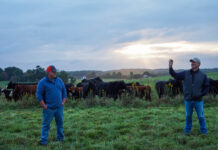Have you ever heard the saying, “The more things change, the more they stay the same?”
From my research, Alphonse Karr is credited for this statement but how many times have each of us repeated this?
It doesn’t seem to matter what industry you are a part of; someone is always coming up with a “new” idea that has been around at least once before.
Education, government, and even agriculture follow trends and while some of the information may be new, much of it refers back to something that worked in the past.
Cover crops are what our producers are reading about this winter in the farming magazines and hearing about on the meeting circuit.
While this is certainly not a new idea, research has shown that cover crops can help solve some of our water quality problems that Jim Mizik from Noble SWCD mentioned last week in his article for Dirt on Conservation.
Farmers worldwide have rotated different crops on their land for many centuries. This agronomic practice was developed to produce higher yields by replenishing soil nutrients and breaking disease and pest cycles.
The increase in monoculture cropping, where the same crop or type of crops are grown in the same field over several years, has been a growing trend in farming in recent decades.
Up to 30 or 40 years ago, you could find most farms following a rotation of hay, oats, or wheat along with corn and soybeans. Today, most large grain farms raise corn and soybeans or all corn to provide feed for livestock. Economics has played into many of these decisions but many folks are starting to look to cover crops as a tool for profit.
Cover crop
A cover crop is an un-harvested crop grown as part of a planned rotation to provide conservation benefits to the soil. Cover crops slow erosion, improve soil organic matter, smother weeds, enhance nutrient and moisture availability, help control many pests, and reduce compaction.
At the same time they can help you increase yields, save on nitrogen costs, reduce trips across the field and also reap many additional agronomic benefits.
Soil and water conservation districts across the state are working to help educate landowners about cover crops. We see this as a team effort and we are as hungry for knowledge as our producers.
One of the things we have heard over and over this winter is that your first question should be: What is my goal for the cover crop?
Do I want to add nitrogen, reduce compaction, capture excess nutrients, build organic matter, or improve weed control?
Every cover crop species has its own niche and characteristic for crop production. Understanding cover crop combinations is essential to success so do your research to understand the management needed to minimize negative outcomes.
The Ohio State University Extension Fact Sheet SAG-9-09 has some good information to help you with these decisions.
Workshop
Like most of you, we want to learn and see the benefits of cover crops. An excellent opportunity for this is a Soil Health Workshop hosted by Dave Brandt at his farm at 6100 Basil Western Road, Carroll, Ohio, April 10, from 9 a.m. to 3:30 p.m.
Brandt is well known, not only in Ohio, but across the nation, for his success with cover crops. Brandt jokes his $300,000 gray and black combine “is the most worthless piece of equipment that I have; I’ve only figured out how to make it do one thing.”
Brandt’s planter stays busy planting corn, soybeans, wheat and vegetables to be harvested, along with sorghum, rye, hairy vetch and sunflower cover crops. He is a perfect example of someone who has re-tooled his cropping system to fit cover crop growth patterns rather than squeezing cover crops into his existing rotation.
For the last two years, we have planted corn and soybeans near the entrance to the city of Coshocton as a Tribute to Agriculture. Last summer, we hand seeded wheat before the corn and soybeans were harvested to prevent erosion over winter.
This spring, we are following current trends and will plant oats to be harvested in July. We will then plant a combination of buckwheat and red clover with sorghumsudan grass forming our “C” in the plot.
Our goal is to improve organic matter in the soil and prevent soil erosion. We also have producers utilizing cereal rye as a cover crop in their operations for soil health benefits, erosion control and as mulch to protect crops.
I would encourage you to work with your local soil and water conservation district as we all learn more about cover crops and their benefits.
Attend educational seminars such as the one at Brandt’s farm, mentioned above; gather information from those who have attempted to grow cover crops; and be open to experimenting with them on your own farm.
Together we can keep our soils healthy and productive and protect the water quality in our communities.












